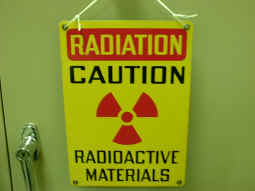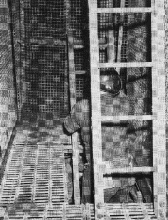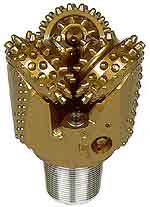| Radioactive - the emission of
radiant energy |
 |
| Raise - A secondary or
tertiary inclined opening, vertical or near-vertical opening driven upward form a level to
connect with the level above, or to explore the ground for a limited distance above one
level. |

|
| Raise bore machine - A machine
using rotary heads of tungsten carbide bits to drill large diameter holes. |

|
| Ramp - A secondary or tertiary
inclined opening, driven to connect levels, usually driven in a downward direction, and
used for haulage. |
 |
| Reclamation – The
restoration of land and environmental values to a surface mine site after the coal is
extracted. Reclamation operations are usually underway as soon as the coal has been
removed from a mine site. The process includes restoring the land to its approximate
original appearance by restoring topsoil and planting native grasses and ground covers. |
 |
| Recovery - The proportion or
percentage of coal or ore mined from the original seam or deposit. |
|
| Regulator - Device (wall,
door) used to control the volume of air in an air split. |
|
| Reserve – That portion of
the identified coal resource that can be economically mined at the time of determination.
The reserve is derived by applying a recovery factor to that component of the identified
coal resource designated as the reserve base. |
|
| Resin bolting - A method of
permanent roof support in which steel rods are grouted with resin. |
|
| Resources –
Concentrations of ore in such forms that economic extraction is currently or may become
feasible. Ore resources broken down by identified and undiscovered resources. Identified
coal resources are classified as demonstrated and inferred. Demonstrated resources are
further broken down as measured and indicated. Undiscovered resources are broken down as
hypothetical and speculative. |
|
| Respirable dust - Dust
particles 5 microns or less in size. |
|
| Respirable dust sample - A
sample collected with an approved dust sampler unit attached to a miner, or so positioned
as to measure the concentration of respirable dust to which the miner is exposed, and
operated continuously over an entire work shift of such miner. |
|
| Retreat mining - A system of
robbing pillars in which the robbing line, or line through the faces of the pillars being
extracted, retreats from the boundary toward the shaft or mine mouth. |
|
| Return - The air or
ventilation that has passed through all the working faces of a split. |
|
| Return idler - The idler or
roller underneath the cover or cover plates on which the conveyor belt rides after the
load which it was carrying has been dumped at the head section and starts the return trip
toward the foot section. |
|
| Rib - The side of a pillar or
the wall of an entry. The solid coal on the side of any underground passage. Same as rib
pillar. |
|
| Rider - A thin seam of coal
overlying a thicker one. |
|
| Riffle - grooves, channels,
slats, or wire screens in a sluice box. |
|
| Ripper - A coal extraction
machine that works by tearing the coal from the face. |
|
| Roasting - The treatment of
ore by heat and air, or oxygen-rich air, in order to remove sulphur and arsenic. |
|
| Rob - To extract pillars of
coal previously left for support. |
|
| Robbed out area - Describes
that part of a mine from which the pillars have been removed. |
|
| Rockbolting - The act of
consolidating roof strata by means of anchoring and tensioning steel bolts in holes
especially drilled for the purpose. |
|
| Rock burst - The sudden
failure of walls or pillars in a mine caused by the weight or pressure of the surrounding
rock, and is accompanied by a violent release of energy. |
|
| Rod mill - A rotating
cylindrical mill which employs steel rods as a grinding medium. |
|
| Roll - (1) A high place in the
bottom or a low place in the top of a mine passage, (2) a local thickening of roof or
floor strata, causing thinning of a coal seam. |
|
| Roll protection - A framework,
safety canopy, or similar protection for the operator when equipment overturns. |
|
| Roof - The stratum of rock or
other material above a coal seam; the overhead surface of a coal working place. Same as
"back" or "top." |
|
| Roof bolt - A long steel bolt
driven into the roof of underground excavations to support the roof, preventing and
limiting the extent of roof falls. The unit consists of the bolt (up to 4 feet long),
steel plate, expansion shell, and pal nut. The use of roof bolts eliminates the need for
timbering by fastening together, or "laminating," several weaker layers of roof
strata to build a "beam." |
|
| Roof fall - A coal mine
cave-in especially in permanent areas such as entries. |
|
| Roof jack - A screw- or
pump-type hydraulic extension post made of steel and used as temporary roof support. |
|
| Roof sag - The sinking,
bending, or curving of the roof, especially in the middle, from weight or pressure. |
|
| Roof stress - Unbalanced
internal forces in the roof or sides, created when coal is extracted. |
|
| Roof support – Posts,
jacks, roof bolts and beams used to support the rock overlying a coal seam in an
underground mine. A good roof support plan is part of mine safety and coal extraction. |
|
| Roof trusses - A combination
of steel rods anchored into the roof to create zones of compression and tension forces and
provide better support for weak roof and roof over wide areas. |
|
| Room and pillar mining –
A method of underground mining in which approximately half of the coal is left in place to
support the roof of the active mining area. Large "pillars" are left while
"rooms" of coal are extracted. |
|
| Room neck - The short passage
from the entry into a room. |
|
| Round - Planned pattern of
drill holes fired in sequence in tunneling, shaft sinking, or stopping. First the cut
holes are fired, followed by relief, lifter, and rib holes. |
|
| Royalty - The payment of a
certain stipulated sum on the mineral produced. |
|
| Rubbing surface - The total
area (top, bottom, and sides) of an airway. |
|
| Run-of-mine - Raw material as
it exists in the mine; average grade or quality. |
|